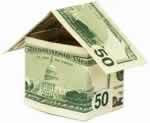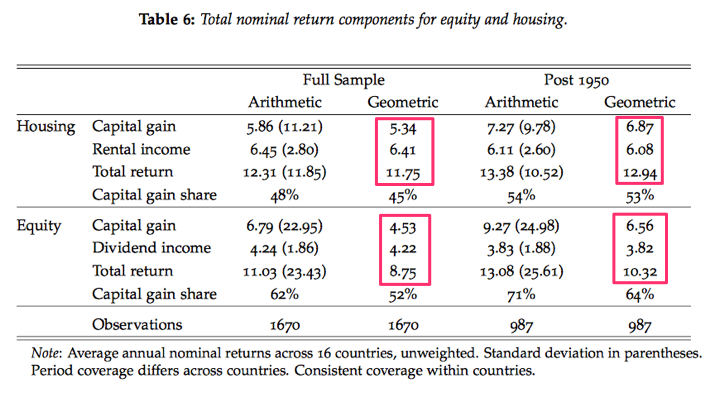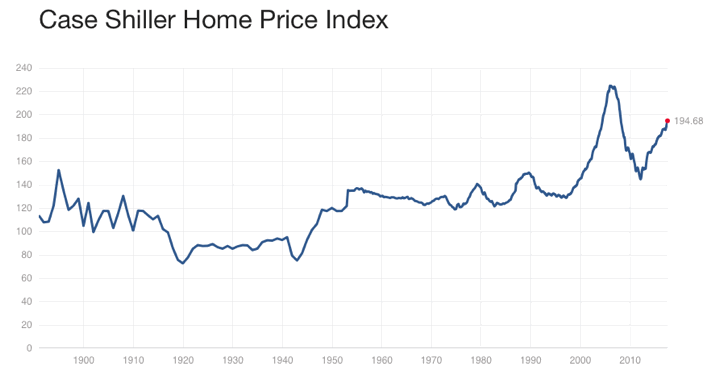 I finally got around to reading an academic paper that looked a bit dry but had a great title: The Rate of Return on Everything, 1870–2015 [pdf] by Jorda, Knoll, Kuvshinov, Schularick, and Taylor. I wonder which of the authors came up with that.
I finally got around to reading an academic paper that looked a bit dry but had a great title: The Rate of Return on Everything, 1870–2015 [pdf] by Jorda, Knoll, Kuvshinov, Schularick, and Taylor. I wonder which of the authors came up with that.
One of the major findings that was residential housing – when you add up the returns from both price change and imputed rent – had a higher overall average return than stocks (equities). Not only did housing have higher returns, but it also had lower volatility (standard deviation). Here’s a chart that compares housing and equities:

When the paper was released, places like the Financial Times discussed the paper’s conclusions but none of them addressed my two immediate questions.
Did they account for the maintenance and management costs of rental real estate? If you own a rental property, you may still have to pay for lawn maintenance, replacing roofs, HVAC units, interior and exterior painting, replacing carpets, and various other issues. To be fairly compared with equities, you should also account for property management costs. Here’s are excerpts that deal with maintenance and repairs:
To the best of the authors’ knowledge, this study is the first to present long-run returns on residential real estate. We combine the long-run house price series presented by Knoll, Schularick, and Steger (2016) with a novel dataset on rents from Knoll (2016). For most countries, the rent series rely on the rent components of the cost of living of consumer price indices as constructed by national statistical offices and combines them with information from other sources to create long-run series reaching back to the late 19th century.
A number of additional issues have to be considered when constructing returns on housing. First, any homeowner incurs costs for maintenance and repairs which lower the rental yield and thus the effective return on housing. We deal with this issue by the choice of the benchmark rent-price ratios. Specifically, in the Investment Property Database (IPD) the rental yields reflect net income (i.e., net of property management costs, ground rent, and other irrecoverable expenditure) received for residential real estate as percentage of the capital employed.
Did they account for the annual property taxes required on residential real estate? In many US states, the annual property tax bill can exceed 1% of the value of the house. Some are closer to 2% annually, and these are owner-occupied numbers. Rental properties may be higher. That’s on top of any potential capital gains you’d owe upon sale of the house, and any taxes you’d owe on rent received. Here’s are excerpts that deal with taxes:
Although the extent of real estate taxation varies widely across countries, real estate is taxed nearly everywhere in the developed world. International comparisons of housing taxation levels are, however, difficult since tax laws, tax rates, assessment rules vary over time and within countries. Typically, real estate is subject to four different kinds of taxes. First, in most countries, transfer taxes or stamp duties are levied when real estate is purchased. Second, in some cases capital gains from property sales are taxed. Often, the tax rates depend on the holding period. Third, income taxes typically also apply to rental income. Fourth, owners’ of real estate may be subject to property taxes and/or wealth taxes where the tax is based upon the (assessed) value of the property.
This section briefly describes the current property tax regimes by country and provides estimates of the tax impact on real estate returns.
With few exceptions, the tax impact on real estate returns can be considered to be less than 1 percentage point per annum.
This is an interesting paper that tries to cover a huge amount of stuff. Estimating the return of all businesses from all countries for the last 150 years? Estimating the return of all residential real estate from all countries for the last 150 years? They mix together a bunch of different datasets, so it’s hard to know exactly the quality level of each and how well they accounted for things like taxes and maintenance.
I’m not sure why they prefer to use arithmetic averages instead of geometric averages, but even if you shave off 1% for additional property taxes and another 1% because you don’t think they account for maintenance costs adequately, housing returns are still at least comparable to equity returns.
Here is the most recent update of the Case/Shiller home price index from Multpl, which tracks US housing prices on an inflation-adjusted basis:

Some people use this to argue that housing returns only keep up with inflation, but home prices ignore the value of rent. The fact that most housing purchases involve a mortgage loan does complicate things a bit.
Bottom line. An interesting paper that compares the long-term returns (last 150 years!) of residential housing and equities. In the long run, some may be surprised that residential housing returns at least matched equity returns, and housing returns had lower volatility. This is a reminder that you can also build wealth via residential real estate, taking into account that rent makes up half of the total return. Stocks are not the only game in town. (Just like with stocks, can is not the same as will.) New services like AirBNB provide an alternate path to monetize residential real estate.
 The Best Credit Card Bonus Offers – 2025
The Best Credit Card Bonus Offers – 2025 Big List of Free Stocks from Brokerage Apps
Big List of Free Stocks from Brokerage Apps Best Interest Rates on Cash - 2025
Best Interest Rates on Cash - 2025 Free Credit Scores x 3 + Free Credit Monitoring
Free Credit Scores x 3 + Free Credit Monitoring Best No Fee 0% APR Balance Transfer Offers
Best No Fee 0% APR Balance Transfer Offers Little-Known Cellular Data Plans That Can Save Big Money
Little-Known Cellular Data Plans That Can Save Big Money How To Haggle Your Cable or Direct TV Bill
How To Haggle Your Cable or Direct TV Bill Big List of Free Consumer Data Reports (Credit, Rent, Work)
Big List of Free Consumer Data Reports (Credit, Rent, Work)
Do the real estate returns take leveraging into account?
I don’t believe so.
One of two costs that is missing for rental property is vacancy costs. Depending on the source, you need to assume the property is going to be vacant 5-10% of the time.
The other costs that is missing is time cost. What is your time worth to do the extra required activities to maintain the rental. Find renters, checking to see if property work is done correctly(the biggest pain for my rentals), finding correct maintenance people, etc… You could pay a property manager to do all of this, but this would further degrade the rental return.
That’s a good question… I’m not sure if their data accounts for average vacancy rates. I would hope so.
They do say they account for property management costs, which the individual owner could avoid but would have to put in their own time. I often look at owning rental properties as a hybrid between running a small business and job with a potential high hourly rate. I don’t like the job description though, so I have so far avoided having a rental property. 😉
I can also speak from my experience. I don’t use management company; for one, it really eats into the “profit” and for two, when it comes to repairs and stuff, they will still want to confirm with you anyway.
Rest assured though. After a while being a landlord, you will have a network of reliable contractors. And the most valuable one among all of them is a general handyman/contractor who can take care of a lot of little issues, knows the housing code and also be able to source other reliable/reasonable priced specialists for you when you have bigger problem. I use this contractor a lot, and he saves me many trips to my 20 miles away rentals because I can trust him. Plus, when we had a really big issue, i.e., my sewage line broke 20 ft under in the front yard and sewage is backing up to the house, he found me a plumber who charges me 2,000 less than anyone I can find, and of course this plumber is fully licensed, call the county for inspection and take care of everything.
And good tenants are GOLD. If you find one, do not let them go (but be happy if they finally can afford purchasing their own home). Do not think about raising that $100 a month. It’s not worth it if that makes the tenant move away. I have a tenant who had been with me for over 4 years. He fixes many things, i.e. roof, leaking faucet, without even bothering me. He takes care of the house so I never had issue when dealing with the rental inspection from the county. So I never raise his rent and I want to keep him forever.
While there are great questions on the estimates and data being used, I still believe that the study has a lot of merit.
After all, most research I have seen discussed on the net focuses on price appreciation only (e.g. Schiller’s chart of US housing since 1890). Usually, the research is used by others to confirm their opinion that housing is inferior to equities.
But those claims completely ignore total returns.
That’s a good point, I’m going to back and add in a note with the most recent Case-Shiller price chart.
I can only speak from my perspective as a homeowner — and from the time frame that I have been (26 years or so). Although we could sell our home at a “profit” today, I would almost be afraid to sit down and back out all the costs of home ownership — a new roof and siding, termite barriers, plumbing repairs, insurance, property tax, mortgage interest, etc. — to see how I’ve really done. I would probably still be in the black, but the margin would be considerably reduced.
In contrast I can buy a stock or a mutual fund — including REITs — and beyond possibly an upfront commission and taxes on annual distributions (which of course can be deferred or even eliminated by using a retirement account), my cost of ownership is very minimal and the profit I eventually realize much more “true.”
As for “imputed rent,” although I understand the concept, it seems to me that it is very much an intangible value that is hard to get a handle on in terms of determining one’s total return on a home. And, it least in my mind, if imputed rent can be roughly conceived as equal to a mortgage payment (plus escrow for taxes and insurance) compared to actual residential rent payment, than it seems to me it’s kind of a wash anyway — at least until one has totally paid off their home.
This all of course if from a long-term ownership perspective of one’s primary home. I will defer to others with more experience on the matter of investment rental properties.
I am also a bit afraid of running the numbers on my primary homeownership as an investment. I think it’s much easier for rental properties as you have both cash flows in and out.
“In many US states, the annual property tax bill can exceed 1% of the value of the house. Some are closer to 2% annually, and these are owner-occupied numbers”. Yikes! I’d gladly settle for 2% as mine exceeds 3% easily in a modest home here in NY.
The paper is looking at 16 countries only one of which is the USA.
If you look at the actual paper Table 5 on page 20 it shows the real rates of return on equities and housing for each country.
In the USA equities out performed housing.
That’s a good point. For the US Equities vs Housing: Full sample 8.39% vs 8.18% and post-1950 8.75% vs 7.58%. I’d still call those numbers in the same ballpark, though. I also wish there was a chart with geometric averages.